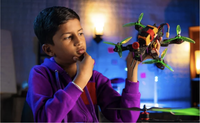The pandemic has certainly presented us with many nearly insurmountable challenges, but challenges also bring change and opportunities for improvement. At Marion County School District, we’ve long been focused on our youngest learners, and meeting the needs of those students has continued to be a source of difficulties and opportunities throughout the pandemic. Here’s how we’ve tried to meet the needs of our youngest learners during the pandemic while also looking to make the future a little brighter.
Putting Early Funds to Use
One of the earliest opportunities we took advantage of was funding from the CARES Act. With this money, we were able to get a device into every student’s hands. We probably should have transitioned to a 1:1 computing environment a while ago, but there were always higher priorities for our limited resources. Of course, devices and Internet connectivity have become not just a high priority, but a necessity in this new remote learning landscape. That ubiquitous access to the Internet has shaped our thinking over the last year and will no doubt continue to shape it after the pandemic is over.
Our decision to go 1:1 was an obvious choice given our circumstances, but if you want to make sure you’re getting the most out of CARES Act funds, our partners at the nonprofit Waterford.org have released a helpful free guide.
Strengthening the Home-to-School Connection
Our teachers have really gone the extra mile throughout this crisis. Our early learning center has a strong Montessori-based component, which is a very hands-on approach to learning. When we went to remote learning, our traditional and Montessori teachers created baggies with all the materials students needed for upcoming lessons. They used disposable items as much as possible, like beans for math manipulatives, so that parents wouldn’t have to worry about bringing them back.
At the time, our teachers were just trying to fill a need the best they could, but the pandemic’s disruption actually became an opportunity to better engage families in their students’ education. Many parents had never had manipulatives in their home before, and they were learning how to use them, and other educational techniques, by watching how teachers interacted with students during remote classes.
One of my teachers told me about a particular four-year-old who was just growing by leaps and bounds. She said she’d asked her mother what she was doing at home and the mother said, “Well, when I’m watching you virtually. I’m picking up on your strategies. And so, when we get out of class, I'm trying to use those same strategies, like the questioning, the wait time.”
Refocusing on Growth and Individuals
Right now, we’re focusing on learning recovery and the key to that is knowing exactly where students are. So many of our students have not had consistent, sound instruction since last spring (2019). As a result, we’re constantly taking advantage of different ways to take a pulse on where each student is. We’ll look at F & P data, NWEA, MAP data, data from individual learning resources—anything we can get our hands on.
We’re interested in achievement, but the main thing we’re looking at is growth. You can’t have achievement if students aren’t growing toward it, after all. We know that students all over the country aren’t where they need to be, so we’re focused more on ensuring that they’re moving in the right direction than on whether they’re already there or not.
Along those lines, I’ve been encouraging our team to focus less on grade levels and more on skills. If we have a child in 5th grade who is reading at a 3rd-grade level, they are probably only missing a handful of skills to bring them closer to grade level. We need to identify those articular skills and work on them specifically.
It’s probably no surprise, then, that I’m a big believer in targeted, small-group instruction. We have teachers pulling kids and intervening with them left and right, but learning losses are so pervasive that the teachers just can’t keep up.
Investing in People and Curriculum
With round two of CARES Act funding, we’re looking to combat those pervasive skills gaps with more personnel. Our hope is to bring in some retired teachers and some new graduates still in need of jobs to begin working with students in and out of the classroom, on-on-one or in small groups.
Another part of our funds will go to digital curriculum. If something is working, we want to expand it to as many students as we can. We’re looking for new resources that are proving effective at helping students grow, and we’ll be expanding existing programs that are working as well.
COVID-19 has certainly presented challenges, but by investing in our students’ future, leaning on the strength of our community within and around the district, and refocusing on nurturing student growth, we’re confident we can come out the other side stronger.
About the author
Dr. Kandace Bethea is the superintendent at the Marion County School District in South Carolina. She can be reached via email at kbethea@marion.k12.sc.us or on Twitter at @bethea_kandace.











